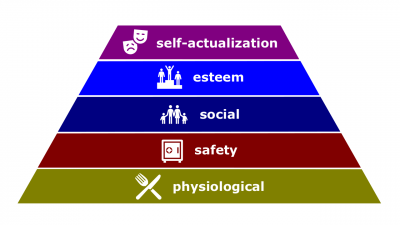Difference between revisions of "Hierarchy of needs"
| Line 1: | Line 1: | ||
[[File:Needs.png|400px|thumb|right|[[Hierarchy of needs]]]][[Hierarchy of needs]] (hereinafter, the ''Pyramid'') is a classification of [[need]]s originally proposed by Abraham Maslow for his [[hierarchy of needs theory]], which was one of [[early theories of motivation]] that suggested that human needs form a sort of hierarchy in which, as each need is substantially satisfied, the next level becomes dominant. | [[File:Needs.png|400px|thumb|right|[[Hierarchy of needs]]]][[Hierarchy of needs]] (hereinafter, the ''Pyramid'') is a classification of [[need]]s originally proposed by Abraham Maslow for his [[hierarchy of needs theory]], which was one of [[early theories of motivation]] that suggested that human needs form a sort of hierarchy in which, as each need is substantially satisfied, the next level becomes dominant. | ||
| + | |||
| + | ==Definitions== | ||
| + | According to [[Organizational Behavior by Robbins and Judge (17th edition)]], | ||
| + | :[[Hierarchy of needs]]. Abraham Maslow's hierarchy of five needs -- physiological, safety, social, esteem, and self-actualization -- in which, as each need is substantially satisfied, the next level becomes dominant. | ||
==Related coursework== | ==Related coursework== | ||
Revision as of 05:03, 26 November 2018
Hierarchy of needs (hereinafter, the Pyramid) is a classification of needs originally proposed by Abraham Maslow for his hierarchy of needs theory, which was one of early theories of motivation that suggested that human needs form a sort of hierarchy in which, as each need is substantially satisfied, the next level becomes dominant.
Definitions
According to Organizational Behavior by Robbins and Judge (17th edition),
- Hierarchy of needs. Abraham Maslow's hierarchy of five needs -- physiological, safety, social, esteem, and self-actualization -- in which, as each need is substantially satisfied, the next level becomes dominant.
